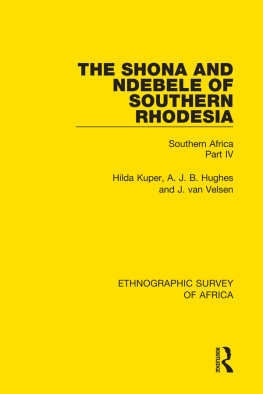First published in 1953 by the International African Institute.
This edition first published in 2017
by Routledge
2 Park Square, Milton Park, Abingdon, Oxon OX14 4RN
and by Routledge
711 Third Avenue, New York, NY 10017
Routledge is an imprint of the Taylor & Francis Group, an informa business
1953 International African Institute
All rights reserved. No part of this book may be reprinted or reproduced or utilised in any form or by any electronic, mechanical, or other means, now known or hereafter invented, including photocopying and recording, or in any information storage or retrieval system, without permission in writing from the publishers.
Trademark notice: Product or corporate names may be trademarks or registered trademarks, and are used only for identification and explanation without intent to infringe.
British Library Cataloguing in Publication Data
A catalogue record for this book is available from the British Library
ISBN: 978-1-138-23217-4 (Set)
ISBN: 978-1-315-30463-2 (Set) (ebk)
ISBN: 978-1-138-23456-7 (Volume 24) (hbk)
ISBN: 978-1-138-23460-4 (Volume 24) (pbk)
ISBN: 978-1-315-30651-3 (Volume 24) (ebk)
Publishers Note
The publisher has gone to great lengths to ensure the quality of this reprint but points out that some imperfections in the original copies may be apparent.
Disclaimer
The publisher has made every effort to trace copyright holders and would welcome correspondence from those they have been unable to trace.
Publishers note
Due to modern production methods, it has not been possible to reproduce all the charts which appeared in the original book. Please go to www.routledge.com/Ethnographic-Survey-of-Africa/Forde/p/book/9781138232174 to view them.
This study is one section of the Ethnographic Survey of Africa which the International African Institute is preparing with the aid of a grant made by the Secretary of State, under the Colonial Development and Welfare Acts, on the recommendation of the Colonial Social Science Research Council.
PRINTED IN ENGLAND BY
HAZELL, WATSON & VINEY, L TD
LONDON AND AYLESBURY
T HE preparation of a comprehensive survey of the tribal societies of Africa was discussed by the Executive Council of the Institute as far back as 1937, but the interruption and restricting of its activities caused by the war resulted in the postponement of the project. Events and developments during recent years, however, have led to a wider recognition of the need for collating and making more generally available the wealth of existing but uncoordinated material on the ethnic groupings and social conditions of African peoples, particularly in connection with plans for economic and social development. Moreover, it appeared that the International African Institute, as an international body which has received support from and performed services for the different Colonial governments, was in a very favourable situation for undertaking such a task.
The Institute, therefore, in 1944 worked out a scheme for the preparation of an Ethnographic Survey of Africa. A committee, under the Chairmanship of Professor Radcliffe-Brown, was appointed to consider the scope and form of the Survey, and collaboration was established with research institutions in South Africa, Rhodesia, East Africa, French West Africa, Belgium, and the Belgian Congo. A grant from the British Colonial Development and Welfare Fund was awarded on the recommendation of the Colonial Social Science Research Council for the purpose of preparing the Survey.
The aim of the Ethnographic Survey is to present a concise, critical, and accurate account of our present knowledge of the tribal groupings, distribution, physical environment, social conditions, political and economic structure, religious beliefs and cult practices, technology and art of the African peoples. The material is presented as briefly and on as consistent a plan as possible, and the text is supplemented by maps and comprehensive bibliographies.
The Ethnographic Survey is being published as a series of separate, self-contained studies, each devoted to one particular people or group of related peoples. It is hoped that publication in this form will make the results more quickly and readily available to those interested in specific areas and groups. A list of the sections which have already appeared is given on p. 88 of this volume.
Since the unequal value and generally unsystematic nature of the available information constituted a chief reason for undertaking this Survey, it will be obvious that the material here presented can make no claim to be complete or definitive. Every effort has been made, however, to scrutinize all available literature and to check it by reference to unpublished sources and workers actually in the field; thus it is intended to present a clear picture of our existing knowledge and to point out the directions in which the need for further study is most pressing. Any assistance from those who are in a position to remedy deficiencies and correct inaccuracies by providing supplementary material will be greatly appreciated.
The International African Institute expresses its thanks to the Colonial Social Science Research Council for recommending the grant which has made possible the initiation of the work, and also desires to thank African Governments and individual officers, and the many scholars, research workers and missionaries in Europe, South Africa and the various African territories who have made available unpublished documents, supplied information and most generously spared time to criticize, correct, and amplify the drafts.
D ARYLL F ORDE ,
Director ,
International African Institute.



